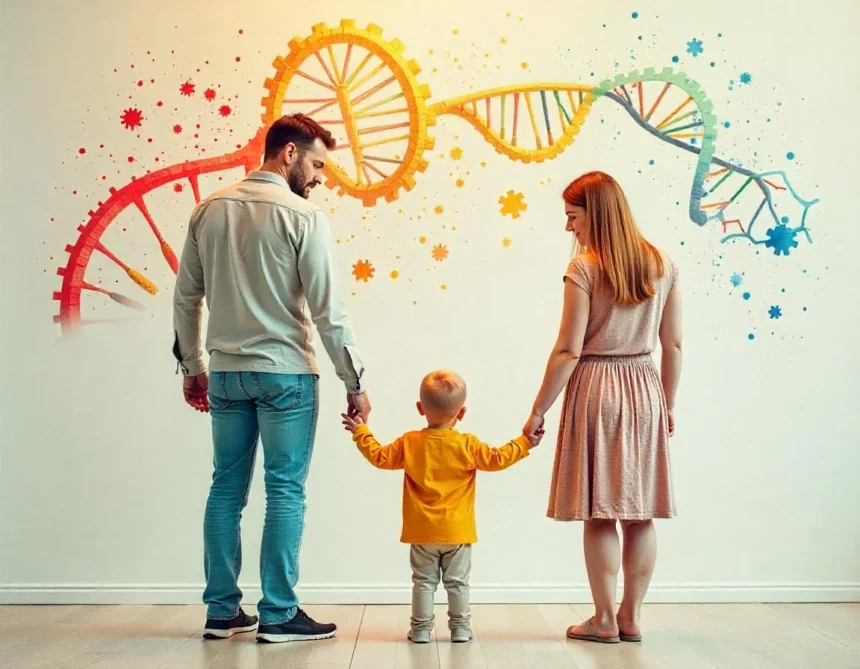Who carries the autism gene, mother or father?Autism has remained a very complex and interesting condition, attracting the attention of scientists, families, and the wider community over the years. More specifically, it poses a vital, but commonly misunderstood question: which one carries the gene for autism the mother or the father? While there’s no direct answer, a plethora of genetic and epigenetic factors are contributing to autism. This article provides an in-depth look at the science to dispel myths and help you understand the latest findings for this complex world of autism inheritance.
Unpacking Autism: A Brief Overview
Before going into the genetic factors, it is important to understand what autism spectrum disorder (ASD) entails. Autism is a developmental condition characterized by differences in social interaction, communication, and behavior. It is called a “spectrum” because it includes a wide range of abilities and challenges.
With prevalence rates on the rise about 1 in 36 children in the United States now receive a diagnosis of autism understanding its causes has never been more important. Genetic and environmental factors both contribute to autism, and genetics are a major player in many cases.
The Role of Genetics in Autism
Scientists have for a long time been studying the genetic basis of autism, one thing being evident: autism is highly heritable; genetic factors underlie up to 80% of all autism cases. But the million-dollar question persists: who possesses the autism gene, mother or father?
Maternal Influence: The Mother’s Genetic Contribution
When it comes to the inheritance of autism, scientific studies often veer towards the maternal lineage. Many researches have pointed out that autism genes or epigenetics may be inherited from mothers. Here’s why:
- Mitochondrial DNA: Nuclear DNA is very different from Mitochondrial DNA, which only gets passed down from the mother. Mitochondria are the so-called “batteries” of the cell, providing nearly all of the energy. Neurological disorders caused by dysfunction within mitochondrial DNA may include autism.
- Maternal Health Conditions: Available evidence has associated maternal metabolic conditions such as Type 1 and Type 2 diabetes, gestational diabetes, and obesity with a risk for autism in offspring. Autism has also been associated with Vitamin D deficiency during pregnancy.
- Epigenetic Modifications: Epigenetics comprises changes in the expression of genes rather than changing the actual DNA sequence. During pregnancy, the epigenome of the developing fetus is sensitive and may be modified by factors such as maternal nutrition, stress, and toxins, further predisposing it to autism.
Paternal Influence: The Father’s Genetic Contribution
While the maternal side often steals the show, fathers also have a very important role in the inheritance of autism. Here’s how:
- De Novo Mutations: These are genetic mutations that occur on their own in a sperm cell or embryo. It is suggested that older paternal age is associated with an increased risk of de novo mutations, which may be associated with autism.
- Genetic Imprinting: Some genes become “imprinted,” meaning that their expression depends on whether they are maternally or paternally derived. Imprinted genes may have effects on the developing brain and behavior.
- Heritability Patterns: Evidence exists to show that paternal transmission of certain autism-related genetic variants is more common compared with maternal transmission. Again, this points toward a complex interaction between maternal and paternal factors.

Epigenetics: The Missing Puzzle Piece?
Adding another layer of complexity to the study of autism has been the emerging field of epigenetics. Epigenetic changes in gene expression are those that are influenced by parents’ lifestyles and environments. Examples include the following:
- Maternal diabetes may epigenetically change the developing fetus to create an autism-related condition.
- Paternal smoking or toxic exposures result in reduced sperm quality and epigenetic modifications of the sperm in such a way as to impact the development of the child.
What Does the Research Say?
There are numerous studies conducted to determine whether autism is inherited from the mother or the father. Here are some findings, though varied:
- Twin Studies:Studies on identical twins showed that when one twin has autism, the chances of the diagnosis of the other twin are 76%. This indicates a strong genetic influence on autism.
- Parental Contributions: There is some research to suggest that mothers may contribute a larger amount of common genetic variants associated with autism, while rare mutations may be more commonly contributed by the father.
- Environmental Factors:Other complicating factors to the pattern of inheritance include maternal stress, paternal age, and environmental toxins.
Practical Takeaways for Parents
While the science is still emerging, there are steps that parents can take now which may support the development of their child:
- Prioritize Maternal Health:Pregnant mothers should maintain optimal health, manage metabolic conditions, and ensure sufficient vitamin D levels.
- Consider Paternal Factors: Prospective fathers can improve sperm quality by adopting a healthy lifestyle, avoiding toxins, and managing stress.
- Stay Informed: Both parents should be aware of the latest regarding research in autism to make informed decisions.
Myths and Misconceptions
Everything about autism and its inheritance seems to be shrouded in myth. Let’s debunk a few of them:
- Myth 1: Autism is solely inherited from the mother.
- Reality: Genetic material is contributed by both parents; therefore, it could be inherited from either side.
- Myth 2: Autism is caused by vaccination.
- Reality: This has been proved wrong through many studies. The main causes of autism are genetic and environmental influences.
- Myth 3: One can cure autism.
- Reality: It is not a disease that needs to be cured; rather, it’s about understanding and supporting individuals on the spectrum.
Looking Ahead: The Future of Autism Research
As science is advancing, much about the genetic and epigenetic underpinnings of autism is being unfolded. Future research is likely to show the role a mother and father both play in autism inheritance. Moreover, technological advances and personalized medicine might promise a better future for sufferers.
Conclusion: Embracing the Complexity
So, who has the gene for autism, the mother or father? It is not as simple as black and white. The parents both contribute to the genetic and epigenetic factors contributing to autism, and active research is still sorting out this complex interplay.
Embracing the complexity of autism, let us change the “why” questions into “how”: how we can support the individuals on the spectrum, celebrate their uniqueness, and make this world more inclusive. We can help grow understanding, break down misconceptions, and champion the incredible diversity that makes us human.

